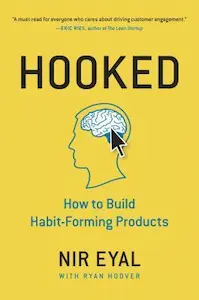Hooked - Summary
Nir Eyal

Introduction
In his book “Hooked: How to Build Habit-Forming Products,” Nir Eyal explores the psychology behind creating products that capture and maintain users’ attention. By understanding the principles of habit formation, businesses can design products that keep users coming back for more. Eyal’s book provides valuable insights into the techniques and strategies used by successful companies to create addictive products. This book summary will delve into the key concepts discussed by Eyal and highlight examples and anecdotes from the book to illustrate his points.
The Hook Model: A Framework for Habit Formation
Eyal introduces the Hook Model as a four-step process that companies can follow to create habit-forming products. The model consists of four stages: Trigger, Action, Variable Reward, and Investment. Each stage plays a crucial role in building user habits.
Trigger: Prompting User Action
The first step in the Hook Model is the trigger. Triggers can be either external or internal. External triggers are cues in the user’s environment that prompt action, such as a notification or an email. Internal triggers, on the other hand, are psychological states that drive users to take action, such as boredom or loneliness.
Eyal emphasizes the importance of understanding users’ internal triggers to create effective products. For example, social media platforms like Facebook and Instagram capitalize on users’ desire for social connection, providing a platform to alleviate feelings of loneliness or boredom.
Action: Making the Behavior Easy
The next step in the Hook Model is the action phase. Eyal explains that the easier it is for users to take action, the more likely they are to engage with a product. He introduces the concept of “the Fogg Behavior Model,” which states that for a behavior to occur, three elements must align: motivation, ability, and a trigger.
Companies can increase user motivation by appealing to their core needs and desires. For instance, fitness apps like Strava tap into users’ desire for self-improvement and competition. By making the action of tracking workouts simple and effortless, Strava encourages users to engage with the app regularly.
Variable Reward: Creating Anticipation
The third step in the Hook Model is the variable reward. Eyal explains that variable rewards create anticipation and keep users coming back for more. When rewards are unpredictable, users become more engaged as they constantly seek the next reward.
Eyal provides the example of slot machines, which are designed to provide variable rewards. The uncertainty of winning keeps players hooked, as they never know when the next big payout will occur. Similarly, social media platforms employ variable rewards through features like likes, comments, and shares, which provide a sense of social validation and keep users engaged.
Investment: Increasing User Commitment
The final step in the Hook Model is the investment phase. Eyal argues that users who invest time, effort, or money into a product are more likely to continue using it. By increasing the user’s commitment, companies can strengthen the habit loop and make it harder for users to switch to competing products.
An example of investment is seen in the gaming industry, where players invest time and effort into leveling up their characters or unlocking new features. This investment creates a sense of ownership and progress, making it more difficult for players to abandon the game.
Ethical Considerations and Criticisms
While Eyal’s book provides valuable insights into creating habit-forming products, it also raises ethical concerns. Critics argue that companies can exploit users’ vulnerabilities and manipulate their behaviors for profit. Eyal acknowledges these concerns and emphasizes the importance of ethical design.
He suggests that companies should focus on creating products that enhance users’ lives rather than exploiting their weaknesses. By providing value and solving real problems, companies can build long-term relationships with their users.
Conclusion
In “Hooked: How to Build Habit-Forming Products,” Nir Eyal presents a comprehensive framework for creating products that capture users’ attention and build long-lasting habits. By understanding the psychology behind habit formation, companies can design products that provide value and keep users engaged.
Eyal’s Hook Model, consisting of triggers, actions, variable rewards, and investments, provides a roadmap for building habit-forming products. Through examples and anecdotes, Eyal illustrates how successful companies have applied these principles to create addictive products.
However, it is crucial to consider the ethical implications of designing habit-forming products. Eyal emphasizes the importance of ethical design and encourages companies to focus on enhancing users’ lives rather than exploiting their vulnerabilities.
By applying the principles outlined in “Hooked,” businesses can create products that not only captivate users but also provide genuine value, leading to long-term success and user satisfaction.